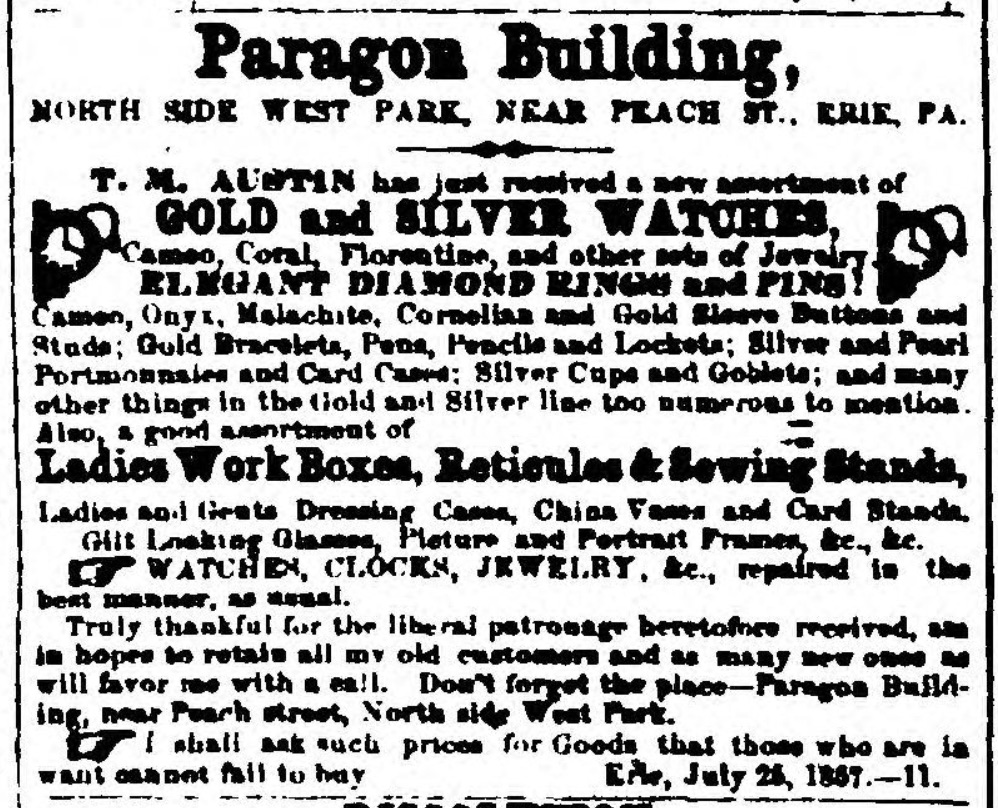
Paragon Building Photo
I was walking down the sidewalk at the west end of North Park Row in Erie when I happened to look up at just the right time. Greeting me from the red-bricked side of the Flagship City Public Market was faded lettering that read “Paragon Building: Clocks, Watches, Jewelry & Fancy Goods.” Made visible by the removal of the neighboring bus terminal, this ghost sign was obviously old, and I couldn’t wait to get home and research its origins.
Finding information about the Paragon Building turned out to be harder than I expected. It wasn’t until browsing old issues of the Erie Weekly Observer that I hit paydirt. Upon turning to page 3 in the August 1, 1857 issue, there it was. T.M. Austin of The Paragon Building, “north side west park, near Peach St., Erie, PA.” had just received a new assortment of gold and silver watches, other sets of jewelry, diamond rings and pins, ladies work boxes, reticules & sewing stands. He also repaired watches, clocks, jewelry, etc. “in the best manner, as usual.” The ad closed by advising, “Don’t forget the place – Paragon Building, near Peach street, North side West Park.”

Ad 8-1-1857 Erie Weekly Observer

Ad 3-12-1859 The Erie Observer
A quick check of Erie County’s property records showed that the Paragon Building was constructed in 1857, one of the first buildings on what soon became known as the Paragon Block. Although it’s not known who owned the building, T.M. Austin, often mentioned in its ads, is a likely candidate and was most closely associated with the Paragon.
Born in Sheffield, Massachusetts in 1818, Thomas Merrill Austin came to Erie some time before 1850. A silversmith and jeweler like his father, he married Clarissa Harris and had four children, Guy, Clara, Anna, and Alice.
Austin was a well-known silversmith, his hallmark being “T.M. Austin. Erie.” In addition to his jewelry trade, he also served the community as a director and manager of Erie’s Home for the Friendless (Sarah Reed, President), a traverse juror, winder of the courthouse clock, and as a captain in John McLane’s 83rd Regiment of PA Volunteers (Civil War). While serving as a company commander under McLane, a shell exploded, hitting Austin in the head. Discharged in 1863 for wounds received in action, it was thought these injuries may have played a role in his failing eyesight and the paralysis he suffered in later life.
The Erie Times-News referred to west North Park Row as the Austin Block in 1888, testimony to Austin’s prominence in Erie and also his likely ownership of the Paragon Building. After living with his wife between 4th and 5th on Holland St., Thomas Merrill Austin died near Troy, NY on December 12, 1897 and is buried in the Erie Cemetery.
Thanks to T.M. Austin and his sign, we haven’t forgotten “the place,” even 166 years later. Memories of Erie’s past continue to live through the Paragon Building, now known as the Flagship City Public Market. If you’re in the area, be sure to take a look at the sign on the building’s east side. (And if you’re able to decipher the very faded letters to the right of “Paragon Building,” please let me know…not being able to read these words is driving me crazy!)

T.M. Austin Hallmark courtesy of Wm Erik Voss 2005
